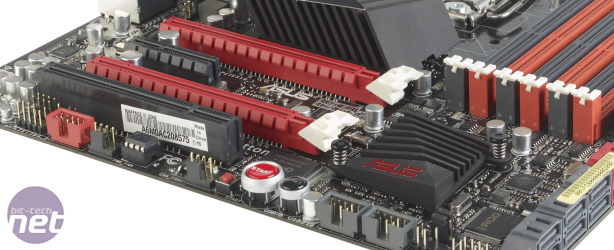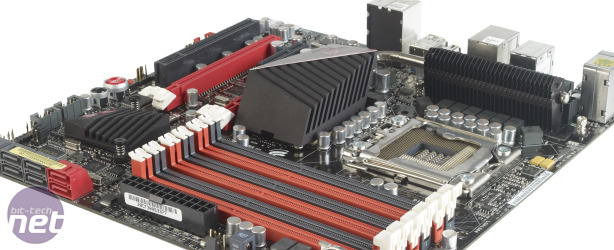Performance Analysis
Micro-ATX boards have a few pros and cons when it comes to performance. They are smaller, so more concessions have to be made in terms of layout and design by manufacturers. This can be an indirect benefit though, as the limited size of the format means companies can’t add too many superfluous features or controller chips, which can take the edge off performance sometimes.Stock-speed Performance
With this in mind, it was good to see the R3G start our tests in a strong fashion with a stock score of 1,509 in our image editing test, only three points behind the top-of-the-table Asus P6X58D-E. The R3G slipped back to mid-table mediocrity when encoding video, but with only 11 points between the top five boards, this isn’t the failure that it first seems. The stock results for our benchmark suite were rounded off by a good showing when multi-tasking to give a stock-speed overall score of 2,091.This puts the R3G ahead of more expensive boards such as the £330 Asus Rampage III Extreme and the £261 Gigabyte GA-X58A-UD7. The fly in the ointment for the R3G at stock speeds is the £167 Asus P6X58D-E which just sneaks ahead of it overall.
Things reversed in our games testing though, with the R3G racing ahead of the pack with a strong minimum frame rate of 38fps in Crysis at 1680 x 1050 with no AA enabled. This is a significant way ahead of its nearest competitor, the P6X58D-E, but it has to be noted that we used the more up to date Catalyst 10.5 for our R3G testing.
The R3G also returned reasonable, if not spectacular SATA speeds of 221MB/sec via its ICH10R based SATA 3Gbps ports and of 216MB/sec from its Marvel 9128-powered SATA 6Gbps ports.
Overclocked Performance
The R3G is a RoG board though, and it comes with the kind of overclocking and enthusiast features that should help it pull ahead of more budget-orientated boards, such as the P6X58D-E, when overclocked. Consequently we were excited to see what it could do when we pushed it.Once we'd spent a little time tinkering we managed to get our test chip up to its air-cooled maximum using the settings we mentioned earlier. This overclock gave the board the healthy boost we're used to seeing from a 4.4GHz Gulftown CPU, and we saw a 25 per cent improvement in most of our tests. Our image editing test returned a epic 1,893, which is just a fraction behind the GA-X58A-UD7 but comfortably ahead of the P6X58D-E. The R3G also performed admirably in our video encoding test, which loves the 12 high-speed worker threads of a Gulftown CPU. The R3G managed to score 4,173, which is the highest score we've seen from an LGA1366 board (if only by about 30 points).
We also saw a solid result from the R3G in our multi-tasking test, though it couldn't beat the GA-X58A-UD7 which owns our multi-tasking test. These strong set of results combined to give an overall overclocked score of 2,618 - the highest overall score we've seen, though only by a fraction.
Gaming performance saw a good jump too with a 6fps boost to the minimum frame rates in Crysis. This is a significant boost and could make the difference between playable frame rates and jerktastic fail-cakes if you’re struggling to play a game at specific settings.

The on-board start and reset buttons are useful, but only if the board is on a test bench. Click to Enlarge
Conclusion
The Asus Rampage III Gene sits strangely in the LGA1366 market. It's part of Asus' RoG brand, so there’s no question that it’s aimed at enthusiasts and overclockers, but it’s a micro-ATX board so it benefits from being cheaper than full sized boards. Its diminutive size has also stopped Asus filling it up with expensive but ultimately irrelevant features, which also helps keep the price down.As a result, at £199 the R3G is significantly cheaper than most of the other enthusiast-level LGA1366 boards, such as Gigabyte's UD7 range and Asus' ATX-sized RoG boards, which makes the board look like a bargain.It does face some stiff competition from elsewhere, however. Asus' more budget orientated board the £163 P6X58D-E is as fast at stock speeds, overclocks to the same level and is almost as fast as the R3G when both are overclocked. As a full-ATX board, the P6X58D-E arguably gives you more system building options too.
The R3G is a great board though: it's compact, looks great, performs well and it offers the chance of building a very powerful micro-ATX system. At £199, it's decent value for money too, even if the P6X58D-E is an even better proposition for getting an LGA1366 system on the cheap (or relatively cheap, at least). If you're looking for an LGA1366 board, then the cheaper P6X58D-E is the better option; if you're looking for a fast, high-quality micro-ATX board, then look no further.
- Performance
- x
- x
- x
- x
- x
- x
- x
- x
- x
- -
- 9/10
- Features
- x
- x
- x
- x
- x
- x
- x
- x
- -
- -
- 8/10
- Value
- x
- x
- x
- x
- x
- x
- x
- x
- -
- -
- 8/10
- Overall
- x
- x
- x
- x
- x
- x
- x
- x
- -
- -
- 8/10

MSI MPG Velox 100R Chassis Review
October 14 2021 | 15:04










Want to comment? Please log in.